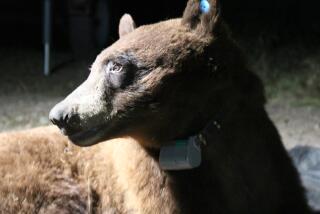Fearless Dogs Give Wayward Bears a Send-Off
- Share via
LAKE WENATCHEE STATE PARK, Wash. — The mere mention of the word “bear” is enough to get Mishka, Tuffy and Cassidy to stand at attention, poised to attack an animal that probably weighs at least 10 times more than they do.
Say “Bark at the bear!” and they’ll do it like actors on cue.
Give them a crack at an actual bear, and they’ll send it barreling away as if it had never encountered something so unpleasant.
After centuries of breeding in Finland, these Karelian bear dogs don’t show a hint of fear when they run toward a bear, pulling their handlers along and barking furiously.
Once spooked, the bears tend to keep their distance for good, making them less likely to be shot and killed for wandering into places where they pose a danger to humans, said Carrie Hunt, a bear biologist who breeds and trains Karelians.
Hunt founded the Wind River Bear Institute in Heber City, Utah, in 1996 to develop a way to teach bears to stay away from roadsides, campgrounds and other places they shouldn’t be, rather than just hauling them someplace else.
“Almost always, relocation ends up with a bear coming back, and it’s dead,” Hunt said.
Two of her dogs, Tuffy and Cassidy, joined Mishka, the only Karelian owned by a wildlife officer in Washington state, for a recent training session for wildlife managers who work in the North Cascades.
With their black-and-white coats and pointy ears, the dogs look a lot like border collies, only stockier and with fluffy, curly tails. Sharp and obedient, they’re the key to Hunt’s tough-love approach to bear management, which she calls “bear shepherding” or “adverse conditioning.”
In carefully choreographed releases, Karelians on 7-foot leashes bark on either side of a bear trap, then chase the bear as it makes its dash to freedom.
“It’s a kick in the pants to see a 40-pound dog taking on an 800-pound bear who’s saying, ‘Oh, no!’ ” said Doug Zimmer, spokesman for the U.S. Fish and Wildlife Service.
Wildlife officers standing near the dogs shoot beanbag rounds and rubber bullets at the bear’s rear end, then fire a loud round of noisy cracker shot in the air.
“Some of them say very quickly, ‘I don’t want to deal with this. I’m out of here,’ ” Hunt said. Other bears will try again, but usually leave for good after a few encounters with the Karelians.
Just in case, an armed officer stands ready to kill the bear, but Hunt says that has never been necessary. Nor have any of her dogs or handlers ever been injured.
“It’s a very safe method,” Hunt said. “In the areas where we’ve worked in Montana, they’ve credited us with saving 16 to 18 grizzly bears that would have been relocated” and probably killed at some point.
So far, the method has worked about 200 times, primarily in Montana and the Canadian province of Alberta, and most recently in Washington state, where two 400-pound black bears were trapped in the backyards of two rural homes southeast of Seattle.
One was set loose in Kanaskat-Palmer State Park; the other was chased away in a remote area along the Snoqualmie River.
Rocky Spencer, a state wildlife biologist and Mishka’s owner, shouted words of encouragement to his 13-month-old dog during the first release. “Good boy! Bark at the bear! Good bark!”
“I really saw a lot of confidence in him,” Spencer said of Mishka after the bear bolted for the woods.
Karelians aren’t cheap. Spencer bought Mishka for $2,000 with a grant from the Seattle chapter of Safari Club International Foundation, a wildlife conservation group.
Using the dogs in the field costs too. The U.S. Fish and Wildlife Service footed the $6,000 bill for Hunt’s weeklong trip to Lake Wenatchee State Park, which included training about two dozen state and federal wildlife managers and helping with the two bear releases.
Although the 30,000-plus black bears in Washington state often get into trouble, it’s the prospect of dealing with the rare and reclusive grizzly that’s driving the federal agency’s interest in Karelians. If grizzlies -- listed as threatened in the Lower 48 states -- began to cause trouble in the North Cascades, federal agents couldn’t shoot them unless a human was under direct attack, Zimmer said.
Tim Manley, a grizzly bear management specialist with Montana Fish, Wildlife and Parks, said Karelians -- and people who’ve learned to be more careful about their trash -- have made his job easier.
“What we’ve found is that, over time, the number of bears we’ve had to deal with has dramatically declined,” he said.
More to Read
Sign up for Essential California
The most important California stories and recommendations in your inbox every morning.
You may occasionally receive promotional content from the Los Angeles Times.













